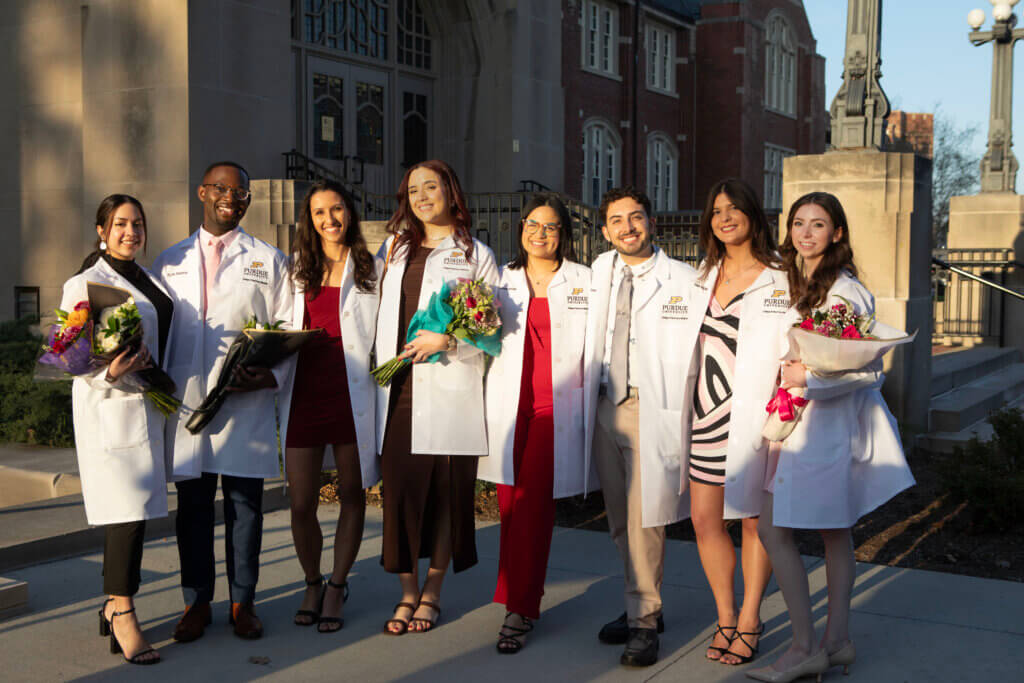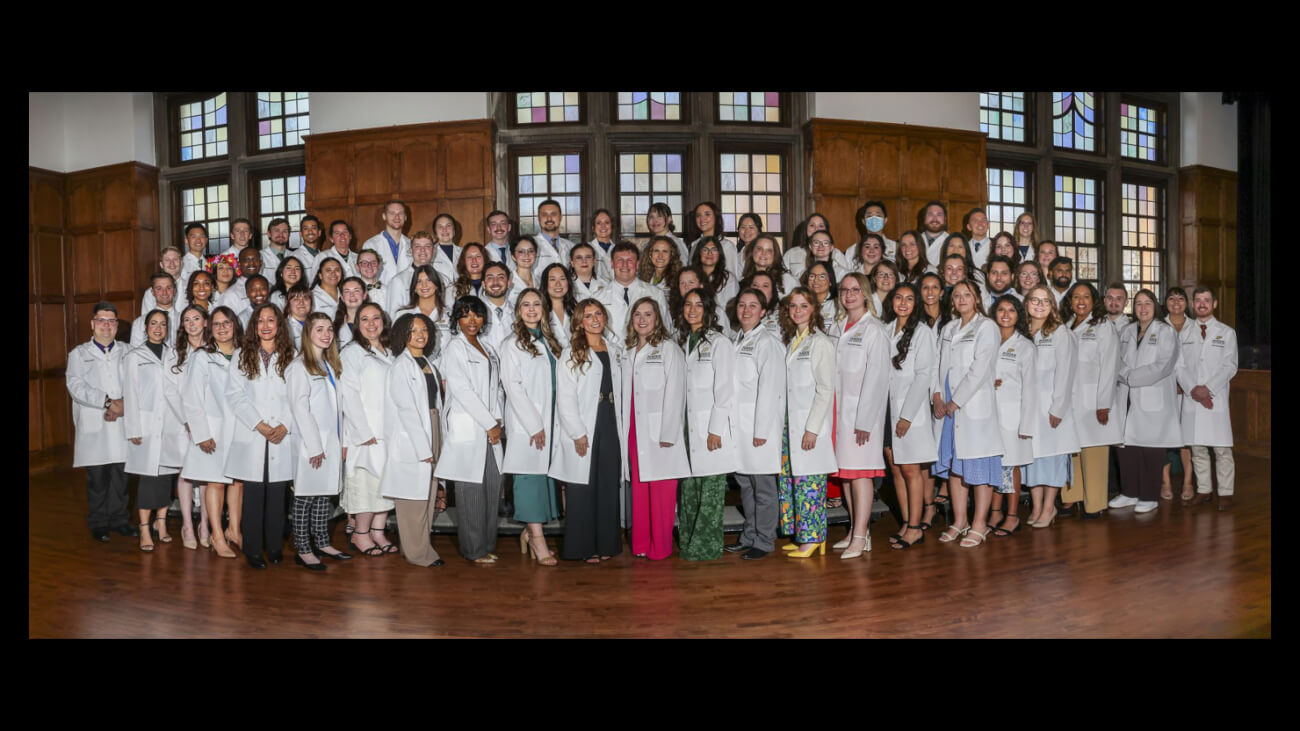The Purdue Memorial Union ballrooms provided a classic setting for an annual event that has become a cherished tradition of the Purdue University College of Veterinary Medicine. Members of the DVM Class of 2026 gathered with family, friends and faculty and staff on the evening of April 12 for the annual White Coat Ceremony that signals the transition of the third year veterinary students from the classroom to the clinics.
The atmosphere was charged with expectation as the capacity crowd awaited the start of the ceremony. Then, as the strains of the Purdue Fanfare rang out, the class members processed through the South Ballroom to their reserved seats in the North Ballroom, carrying their neatly folded white coats.

Dean Bret Marsh then addressed the audience, commenting on how wonderful it was to have the students’ families, friends and loved ones together to celebrate the special occasion, which recognizes a “rite of passage” for the third year DVM Class. Dr. Marsh also thanked the supporters of the event, including alumni and friends who sponsored the white coats, and the Indiana Veterinary Medical Association.
The White Coat Ceremony symbolizes the students’ transition into their new role as junior veterinarians, and their acceptance of the great responsibility they will have toward their patients and clients. In keeping with another traditional element of the ceremony, the students selected a faculty member to speak at the ceremony and share words of wisdom and advice. That person was Dr. Joanne Messick, professor of veterinary clinical pathology in the Department of Comparative Pathobiology. Dr. Marsh introduced her as a faculty member who is deeply committed to shaping the next generation of veterinarians, not just by teaching but by inspiring curiosity, critical thinking and a passion for pathology.
Dr. Messick said it truly was an honor to be part of this special moment for the class. “I’d like to begin with a few reflections on what this year means and how to make the most of it,” Dr. Messick said. She went on to explain that the White Coat Ceremony is a celebration “…of your resilience, your growth, and your readiness. You began this journey as veterinary students – bright-eyed, eager, and full of ambition. Along the way, the weight of your studies, the long nights, and the constant challenges may have dimmed that initial spark. But today, standing here, I see that light in your eyes again.”
Dr. Messick continued by explaining that this moment marks a powerful transition-from student to doctor-in-waiting. “Donning the white coat symbolizes a shift in identity,” Dr. Messick said. “You’re stepping into a new role – not just learning from the sidelines, but being an important part of the care team, making decisions, and owning the responsibility that comes with the title, ‘Doctor.’”
She then shared several tips for how the students could make the most of their clinical year:
- Stay curious
- Take ownership
- Stay positive
- Reflect often
- And most important, “…take care of yourself.”
Dr. Messick concluded on a lighter note, recalling a skit in which one of the students impersonated her, cradling a Chihuahua, instead of her actual favorite breed, which is the Papillon. But Dr. Messick explained the skit marked “…a connection, a shared journey – and a realization that we’re in it together, every step of the way.”
With that intro, Dr. Messick then called forward Instructional Technologist Jeannine Henry, RVT, to help share a poem that they wrote for the class about a Papillon, as Jeannine held a small Papillon stuffed animal that they would later give to the class with instructions for each student to take turns keeping it four days at a time throughout the coming year.
The Gift of the Papillon
On your white coat day, she is ever near
A Papillon to guide and steer
Through moments light and trials deep,
She’ll walk beside you, calm and sweet.She’ll travel with you through your final year
For four days each, you’ll share her cheer
Then pass her on to the next in line,
As you all grow, her light will shine.With each new step toward healing’s art,
She’ll be the spark that fuels your heart.
Through struggles and growth, she’ll guide your way
To be great doctors, each-and-every-day.Take care of her with heart and mind,
For in your soul, her love you’ll find.
A part of Purdue, a part of you,
The Papillon’s gift, forever true.
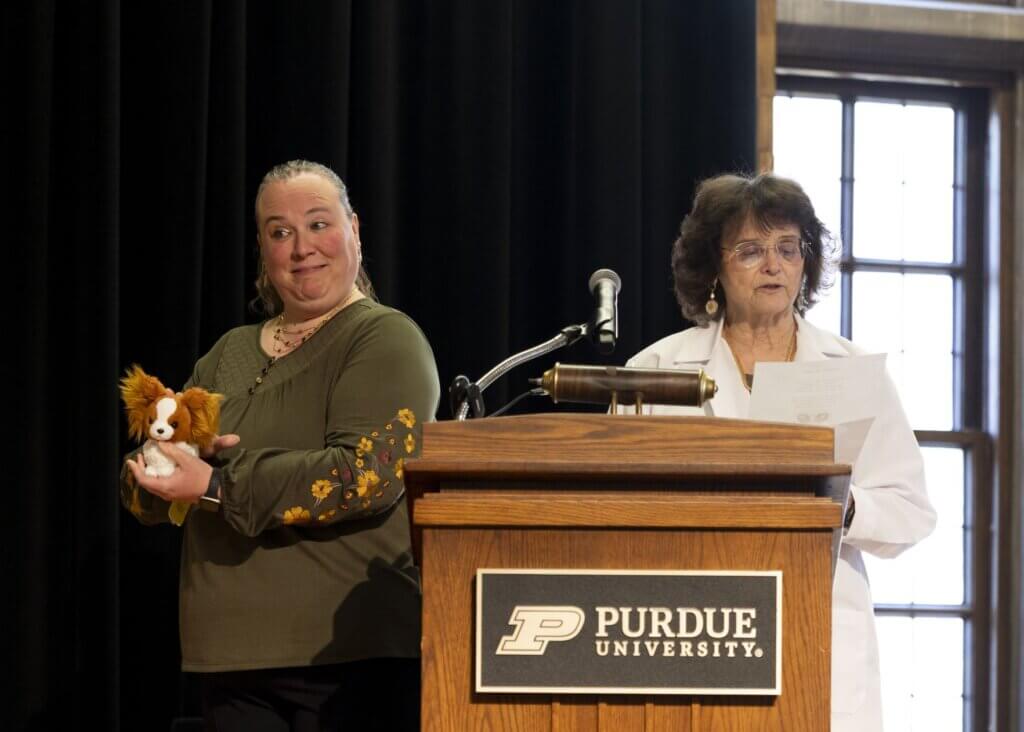
The class then heard timely words of advice from a fellow student in the class ahead of them, Sydney Gehlhausen, of Jasper, Indiana, who is just finishing her clinical year and plans to practice emergency medicine in Indianapolis after graduation.
Next, Kathy Salisbury, associate dean for academic affairs, came to the podium to call forward each class member. As their names were announced, the students ascended the stage and each brought their coat to Dean Marsh, who formally placed it on them before pausing for a ceremonial keepsake photo. After all the students were introduced, the class posed for an official class picture, serenaded by a round of rousing applause.
Before the program concluded, Dean Marsh presented several awards that are designated for members of the third year class. The following students were recognized as recipients:

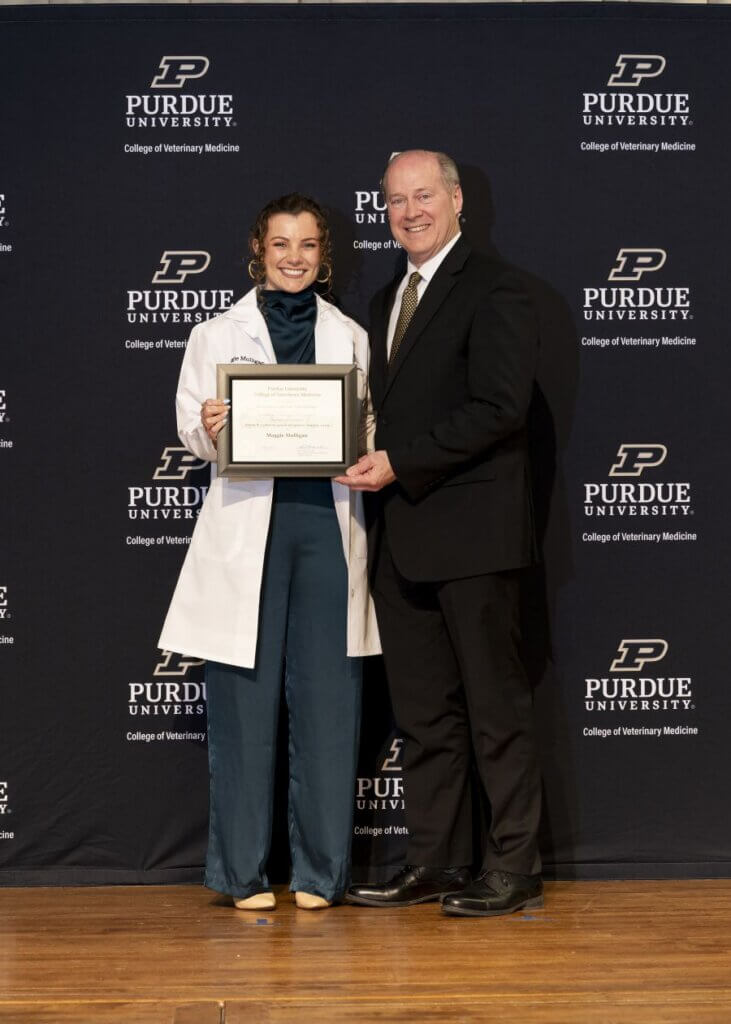
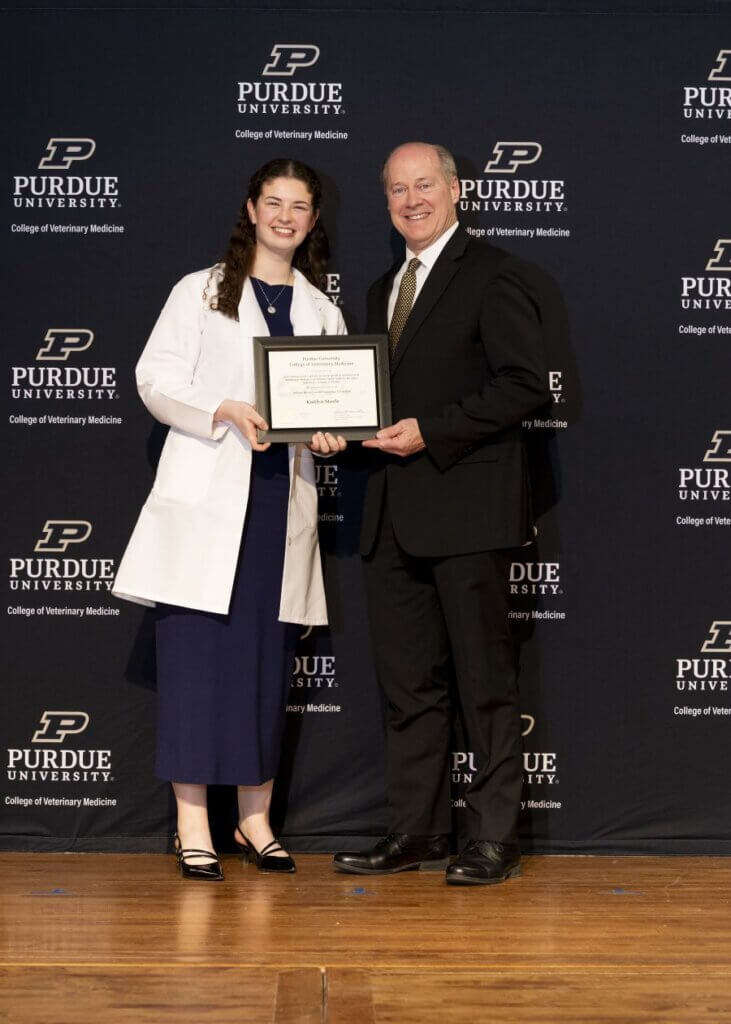
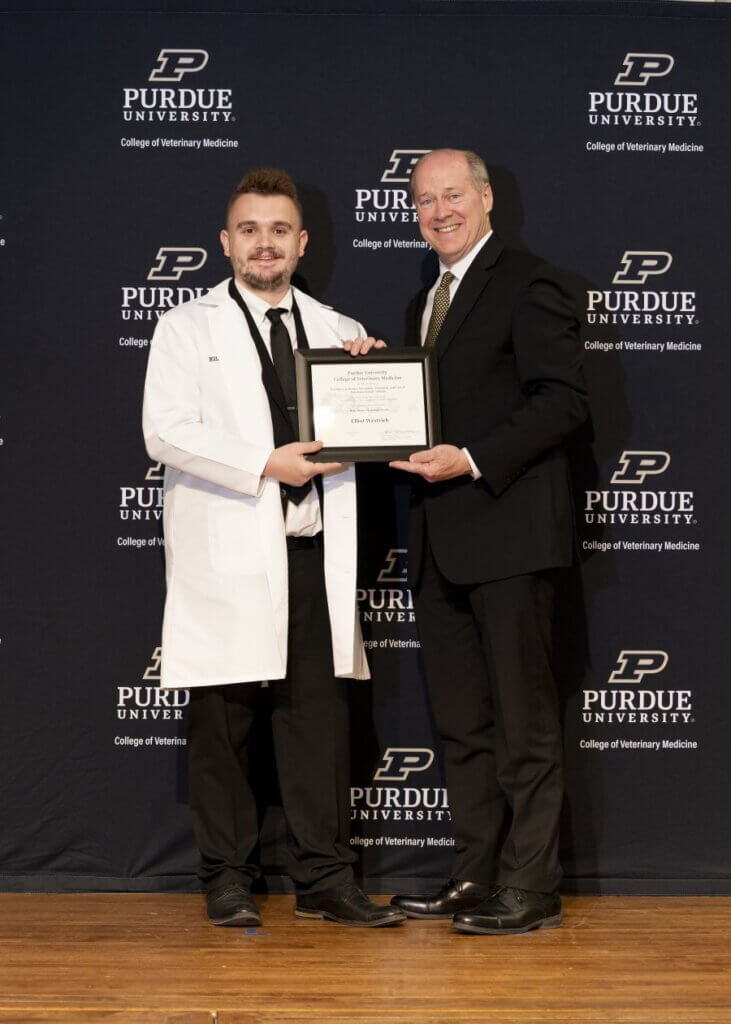
- Maggie Mulligan received the Dr. William W. Carlton Award for Aptitude in Veterinary Pathology, which was established by Dr. William H. Jordan of the DVM Class of 1973 and his fellow alumni as a tribute to the late Dr. Bill Carlton, the Leslie Morton Hutchings Distinguished Professor Emeritus of Veterinary Pathology. The award is given in honor of Dr. Carlton’s tireless contributions to veterinary pathology education, and recognizes a third-year veterinary student who has shown aptitude in the field of pathology through superior academic performance in pathology studies. The award consists of a certificate and a cash prize. Maggie is from Kentland, Indiana, and as a veterinary student, she is active in the pathology club, serving as president. She also is the SAVMA Purdue secretary.
- Kaitlyn Steele received the Indiana Horse Council Foundation Equine Industry Award, which is given to a student who has provided other students with the greatest exposure to the equine industry. The recipient is selected by peers and the award includes a monetary prize and a certificate. An engraved nameplate also is affixed to the permanent plaque which is displayed in Lynn Hall. Hailing from Valparaiso, Indiana, Kaitlyn has been an active member of the college’s Equine Club and also served as Open House chair.
- Elliot Westrich received the Holly Watts Memorial Award, which is given to a student who is selected by a vote of the members of the Exotic Animal Club. The award is a tribute to a veterinary student named Holly Watts, who passed away in 1983 during her junior year. Established by her family and members of the class of 1985, the Holly Watts Memorial Award recognizes a student with exceptional interest and proficiency in non-domestic animal medicine. The award consists of a framed certificate and a cash prize. Elliot is from Evansville, Indiana and as a veterinary student has served as fundraising chair for the Exotic Animal Club, President of the Feline Club, and Treasurer of SAVMA.
- Audrey Evans was recognized for serving as president of SAVMA Purdue, which is an important leadership role that is traditionally filled by a third-year veterinary student. Audrey is from Fishers, Indiana. She was honored for her outstanding tenure as president of the Purdue Chapter of the Student American Veterinary Medical Association, which functions as the student body government in the college. Audrey received an engraved Cross pen in recognition for her work.
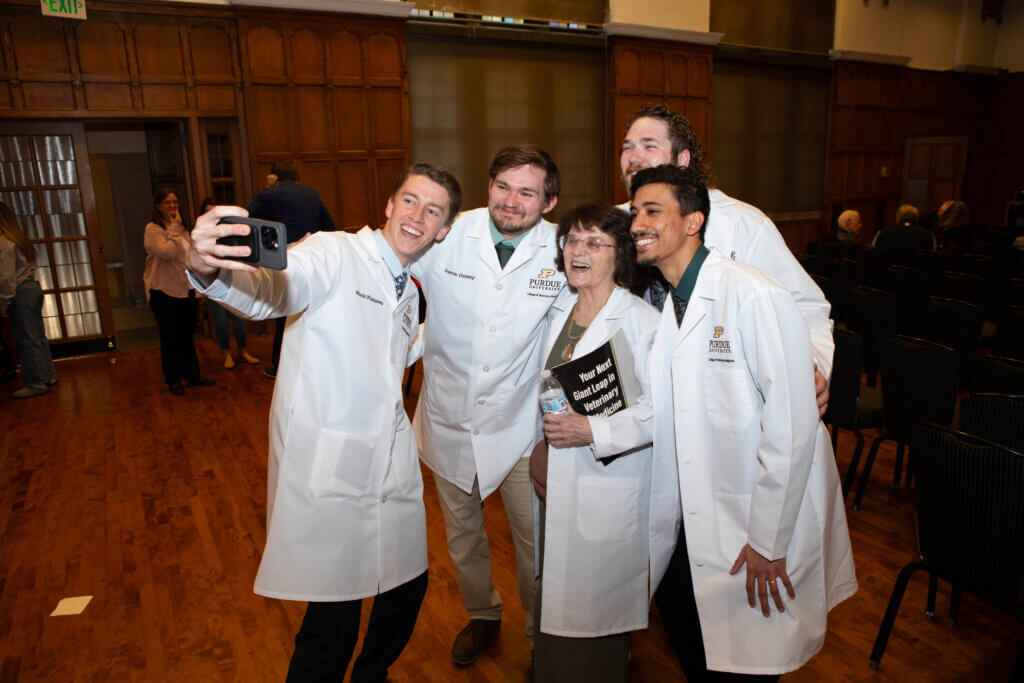
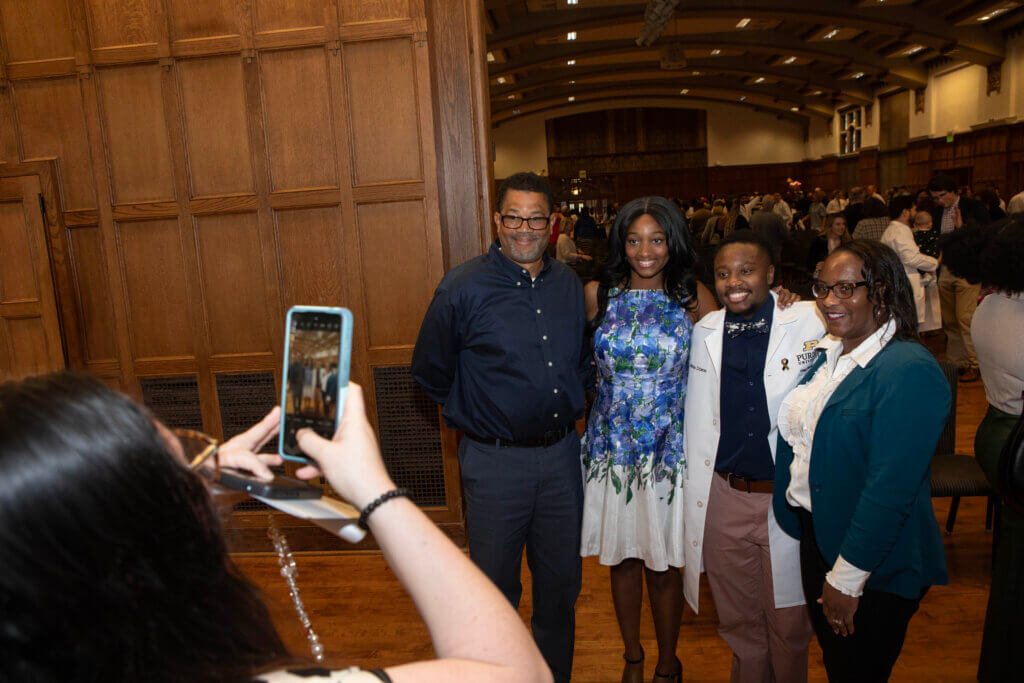
The White Coat Ceremony concluded with a reception and an abundance of photo ops. Professional photos of the event taken by Ed Lausch are available to view and purchase online at www.lauschphotography.com. Look in the Client Galleries section for 2025 Purdue Veterinary Medicine and use the password “2025PVM”.
Congratulations to the Class of 2026!
